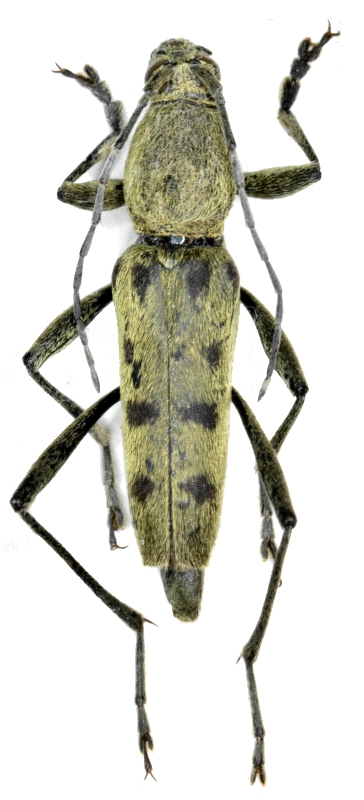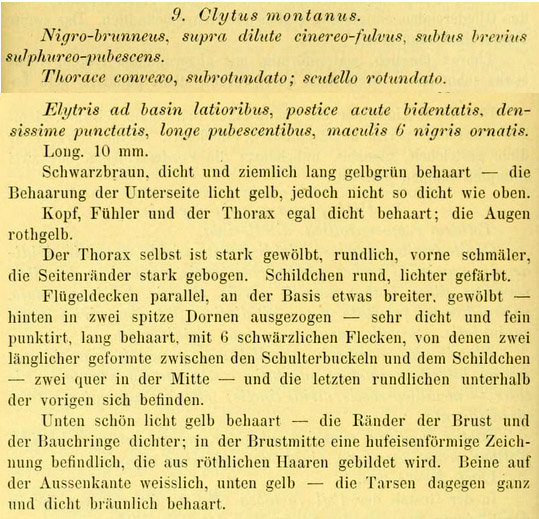| T O P I C R E V I E W |
| Francesco |
Posted - 15/11/2017 : 08:35:43

145.63 KB
Laos, Muang Khoa
Do you know this species?
Rhaphuma or Chlorophorus? |
| 9 L A T E S T R E P L I E S (Newest First) |
| Xavier |
Posted - 09/07/2018 : 02:06:56
Voici la redescription de Gahan(1906) :
Blackish brown, clothed with dense and somewhat long yellowish-brown pubescence ; the pubescence on the underside light yellow, not so dense as on the upperside. The pubescence on the head, the autennae and thorax of even denseness, the eyes reddish yellow. The thorax itself is strongly arched, cylindrical, narrowed anteriorly, the sides strongly curved outwards. The clypeus rounded, somewhat paler in colour. Elytra parallel-sided slightly broader at base, convex, ending posteriorly in two acute spines ; very densely and finely punctured, clothed with lone pubescence; marked with six blackish spots, of which two of elongate shape are placed between the pronotal convexity and the scutellum, two transversely in the middle, and two rounded ones below these. Underside clothed with beautiful light yellow pubescence, most densely between the breast and the abdominal segments ; in the middle of the breast is a horseshoe-shaped mark of red pubescence. Legs whitish on the outer side, yellow beneath, the tarsi densely and completely covered with brown pubescence.
" Length 10 mm. Hab. Manipur.
Je comprends qu'il y a 2 x 3 taches en tout. Mais la photographie que j'ai placée ici montre que c'est plutôt 2 x 5, plus ou moins visibles.
|
| Francesco |
Posted - 09/12/2017 : 16:53:26
A mon avis, il a 6 taches pour chaque élytre... |
| Xavier |
Posted - 09/12/2017 : 15:05:30
Je viens de trouver : il s'agit probablement de Clytus montanus Nonfried, 1894 de l'Himalaya (même zone biogéographique que le Laos) dont Gahan (1906, sp. n° 287) dit que c'est une espèce marquée de 6 taches noires sur les élytres.
Il faudrait trouver le moyen de vérifier cette détermination car ma série (Laos principalement) est constituée de spécimens aux taches variables ( 2 X 5 en général, mais aussi 2 X 4 ou seulement 2 X 3 taches )
Cette espèce est extrêmement fréquente et répandue en Asie du sud-est, et elle pourrait très bien avoir été décrite dans le genre Clytus... j'ai un peu de mal à croire qu'elle ne soit pas passée entre les mains de Pic, et que les Rhaphuma eleodina Gressitt & Rondon, 1970 & Chlorophorus fraternus Holzschuh, 1992 ne sont pas des synonymes d'une espèce précédemment décrite (mais tout est possible).
Pour que tu puisses quand même vérifier (même si j'y crois guère en lisant la redescription de Gahan) , voici la description originale:

154.92 KB |
| Xavier |
Posted - 07/12/2017 : 17:53:55
Je ne sais pas, ...ce site est tenu par des Tchèques et leurs déterminations sont plutôt justes en général. Cela m'intrigue. |
| Francesco |
Posted - 07/12/2017 : 16:35:16
Une autre nouvelle espèce de quelque entomologiste très fantaisiste?  |
| Xavier |
Posted - 07/12/2017 : 12:56:54
Bizarrement, sur un site marchand d'internet, cette espèce (du nord-Laos) est vendue sous le nom " Chlorophorus montanus". Je ne trouve aucune référence bibliographique pour ce nom. |
| Francesco |
Posted - 02/12/2017 : 13:13:56
En revenant ici, c'est un Chlorophorus quoiqu'il pense Gressitt & Co. |
| Francesco |
Posted - 15/11/2017 : 09:55:59
Merci Xavier... J'avais oublié ce post. |
| Xavier |
Posted - 15/11/2017 : 09:01:23
Cette espèce est très commune, ...et difficile; mais regarde ici .
J'ignore encore quelles sont les espèces proches & celles qui sont synonymes. |
|
|


